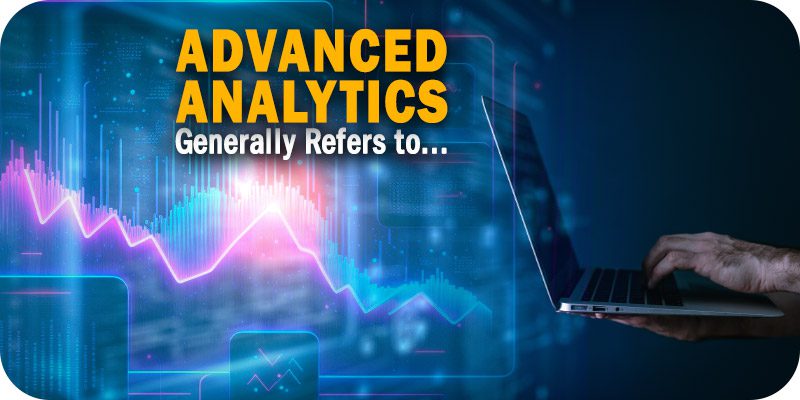Advanced Analytics Generally Refers to What Exactly?


Solutions Review’s Tim King offers a brief on the topic of advanced analytics. In this resource, he answers the question: advanced analytics generally refers to what exactly?
Advanced analytics represents a paradigm shift from traditional data analysis methods, allowing organizations to move beyond basic data exploration and uncover nuanced patterns, correlations, and trends. The foundation of advanced analytics lies in robust data integration and preparation, where diverse datasets are harmonized, cleansed, and transformed to ensure consistency and quality. This critical first step paves the way for subsequent analytical techniques.
Advanced Analytics Generally Refers to…
Descriptive Analytics
Descriptive analytics involves harnessing historical data to gain insights into past events, patterns, and trends. Techniques such as data visualization, dashboards, and reports enable stakeholders to comprehend complex information effortlessly. Visualization tools provide intuitive representations of data, facilitating the identification of patterns and anomalies that might have otherwise remained hidden.
Predictive Analytics
Predictive analytics leverages historical data to build models that forecast future outcomes. Through regression analysis, time series forecasting, decision trees, and other machine learning algorithms, predictive analytics empowers organizations to anticipate trends, customer behavior, and market dynamics. This capability enables proactive decision-making and the formulation of strategies that maximize opportunities and mitigate risks.
Prescriptive Analytics
Prescriptive analytics goes beyond predictions and provides recommendations for optimal decision-making. By employing optimization techniques and simulation models, prescriptive analytics identifies the best course of action based on predefined objectives and constraints. This component guides organizations in making informed choices, streamlining operations, and optimizing resource allocation.
Data Mining
Data mining techniques are instrumental in discovering hidden patterns and relationships within large datasets. Through clustering, classification, association rule mining, and anomaly detection, data mining uncovers valuable insights that can be translated into actionable strategies. By unearthing previously unseen connections, organizations can enhance product offerings, target specific customer segments, and improve operational efficiency.
Machine Learning
Machine learning, a subset of artificial intelligence, equips computers with the ability to learn from data and improve performance without explicit programming. Supervised learning, unsupervised learning, and reinforcement learning algorithms enable systems to recognize patterns, make accurate predictions, and automate decision-making processes. Machine learning empowers organizations to derive valuable insights from vast datasets and adapt swiftly to changing business landscapes.
Natural Language Processing (NLP)
NLP enables the analysis and interpretation of human language data, such as text documents and speech. By employing sentiment analysis, entity recognition, topic modeling, and text classification, NLP uncovers underlying sentiment, meaning, and intent within textual data. Organizations can leverage NLP techniques to gain insights from customer feedback, social media posts, and unstructured textual sources, enhancing brand reputation management, customer service, and information retrieval.
Big Data Analytics
With the exponential growth of data, big data analytics has emerged as a critical component of advanced analytics. It involves processing, analyzing, and extracting insights from massive datasets that surpass the capabilities of traditional data processing tools. Utilizing distributed computing frameworks like Hadoop and NoSQL databases, big data analytics enables organizations to unlock hidden patterns, perform complex calculations, and extract actionable insights.
Real-time analytics focuses on analyzing data as it is generated, allowing organizations to make immediate decisions and take timely actions. By processing and analyzing streaming data from sensors, social media feeds, and IoT devices in real time, organizations gain valuable insights into rapidly evolving situations. Complex event processing (CEP) and in-memory data processing technologies facilitate fast and continuous analysis of data streams, enabling organizations to respond promptly to critical events and optimize operational efficiency.
Text Analytics
ext analytics plays a vital role in extracting insights from unstructured textual data, such as emails, social media posts, customer reviews, and documents. Leveraging NLP techniques, including sentiment analysis, entity recognition, topic modeling, and text classification, organizations can derive valuable insights from vast amounts of textual data. Text analytics enables sentiment analysis, customer feedback analysis, and information extraction, aiding in decision-making, improving customer satisfaction, and identifying emerging trends.
Geospatial Analytics
Geospatial analytics combines location data with other datasets to gain insights into spatial patterns, relationships, and trends. By analyzing and visualizing data on maps, organizations can understand spatial dynamics, optimize logistics and supply chain operations, and make location-based decisions. Geospatial analytics finds applications in urban planning, environmental monitoring, marketing, and transportation, facilitating informed decision-making and improving resource allocation.
Network Analytics
Network analytics focuses on analyzing complex networks, such as social networks, communication networks, and transportation networks, to understand relationships, connectivity, and network behavior. By examining the nodes, edges, and interactions within a network, organizations can uncover patterns, detect anomalies, and optimize network performance. Network analytics enables organizations to identify influential nodes, understand information flow, and enhance network security and efficiency.
Advanced analytics encompasses a wide range of components that enable organizations to extract valuable insights from complex and diverse datasets. By combining data integration and preparation, descriptive analytics, predictive analytics, prescriptive analytics, data mining, machine learning, NLP, big data analytics, real-time analytics, text analytics, geospatial analytics, and network analytics, organizations can uncover hidden patterns, make accurate predictions, and make data-driven decisions. As the era of big data continues to evolve, advanced analytics plays a pivotal role in transforming raw data into actionable intelligence, empowering organizations to gain a competitive edge and drive innovation across various domains.































